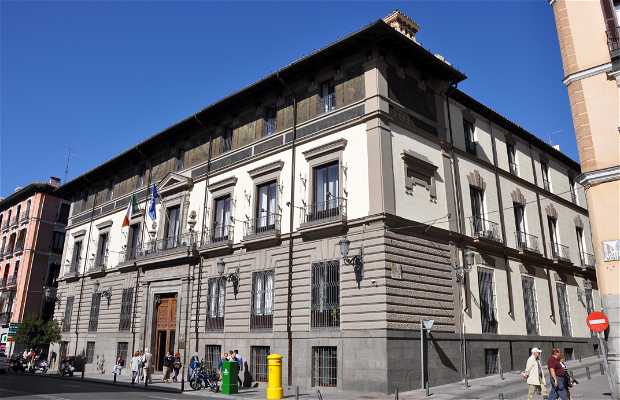Historic events
I cross Mayor street and right in front of me, at building number 86, is the Abrantes Palace, built in the 17th century under the mandate of D. Juan de Valencia, (Top Spy of the Majesty’s Secret Council). Juan Maza was the architect in charge of its completion.
For centuries, ownership of the building changed between local nobles until 1842, when the Dukes of Abrantes bought it. They put Anibal Alvarez Bouquel in charge of carrying out renovations on the house. The dukes then sold it to Manuel Maria de Santa Ana, who proceeded to set it up as headquarters of the La Correspondencia de Espana newspaper. In 1888, it was sold to the Italian Governor, who set up his country’s embassy and once again renovated the building. This time, the decoration of the ceiling was changed to be a series of striking paintings. During the Spanish Civil War, from 1936 to 1939, the building was used as the barracks for the primary Italian members of the International Brigade. Once the conflict was finalized, the embassy was then moved to its current location on Juan Bravo Street and the palace has since been occupied by the Italian Institute of Culture.
It’s the building’s interior that really stands out. Maybe its patio of lights on the right side of the stairway that heads towards the lecture halls. However, on one of the streets surrounding the building, Factor Street, Juan de Escobedo, the secretary of D. Juan de Austra and half brother of Felipe II, was assassinated on March 31, 1578, on Easter Monday. It’s said that Escobedo discovered, thanks to shady business deals, the love affair between D. Antonio and the princess Eboli, Ana de Mendoza de la Cerda, widower of Ruy Gomez de Silva, former secretary of the Consejo de Hacienda. It’s also said that the King was involved in the assassination.
Another painful event took place at number 88 Mayor Street on the 31st of May, 1906. It was the day of the wedding between Alfonso XIII and Victoria Eugenia. From a guesthouse located on the third flood, Mateo Morral threw a branch of flowers with a bomb inside towards the wedding procession. The branch landed on the tranvia’s electric wire. The King’s life was saved but thirty people were killed in the act.
From there, I round the corner and head towards the Plaza Mayor. To my left I notice an old restaurant, the Casa Ciriaco (Mayor, 84). It’s an absolute classic in Madrid. It has good food at a good price, plus a special charm.






